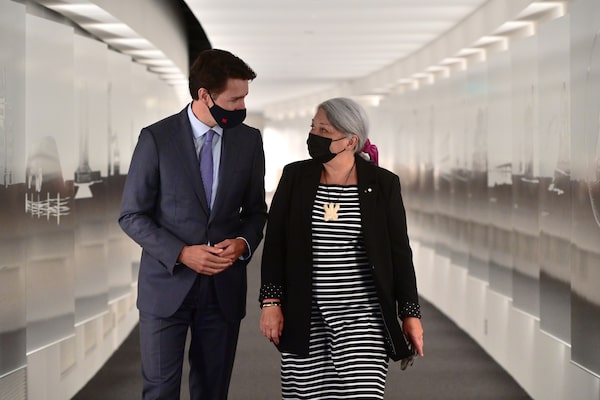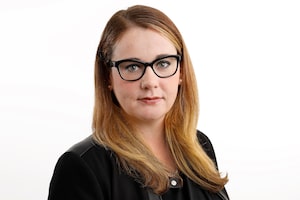
Prime Minister Justin Trudeau and Mary Simon arrive for an announcement at the Canadian Museum of History in Gatineau, Que., on Tuesday, July 6, 2021.Sean Kilpatrick/The Canadian Press
Mary Simon, an Inuk leader, former diplomat and broadcaster, will become the first Indigenous person to serve as governor-general, a historic appointment made while Canada grapples with the continuing effects of colonialism.
Ms. Simon said she understands “that there is pain and suffering across our nation.” She also said the country needs to stop to fully recognize and memorialize the past that “we are learning more about each day.” Recent discoveries of hundreds of unmarked graves at former residential schools in several provinces have sparked sadness and anger at the atrocities committed against Indigenous peoples in this country, and led to increased calls for reconciliation.
“When I was asked whether I would take on this important role, I was very excited and I felt that this was a position that would help Canadians together with Indigenous peoples,” Ms. Simon said in Gatineau on Tuesday.
Ms. Simon is known as an advocate of Inuit rights. She has served as president of Inuit Tapiriit Kanatami (ITK), Canada’s national Inuit organization, and was a key player in the creation of the Inuit Circumpolar Council, which brings together the Inuit of Canada, Alaska, Greenland and Russia. She also travelled the country as part of a federal commission seeking ways to improve mental-health services.
Prime Minister Justin Trudeau announced her selection on Tuesday and said it was an honour to have Ms. Simon serve as Canada’s first Indigenous governor-general. He said that, on his recommendation, the Queen approved her appointment.
“Today, after 154 years, our country takes a historic step,” Mr. Trudeau said. “I cannot think of a better person to meet the moment.”
Governors-general represent the Queen, Canada’s head of state, and carry out some of the key ceremonial functions that keep our constitutional monarchy running. Their duties include:
- Dissolving and opening Parliament: When it’s time for a federal election, the governor-general starts the process. Then, when a new parliament begins, the governor-general reads the Throne Speech setting out the government’s priorities.
- Political oaths: The governor-general administers the oaths of office to prime ministers, cabinet ministers and chief justices of the Supreme Court.
- Royal assent: Once bills are approved by the House and Senate, they have to be assented to by the governor-general before they come into force. No governor-general has ever refused such assent.
- Diplomatic duties: Abroad, governors-general represent Canada at state functions. At home, they play host to visiting foreign leaders and receive official documents from new ambassadors that allow them to take their posts.
- Military duties: The governor-general is commander-in-chief of the Canadian Armed Forces.
To perform these roles, governors-general have to be strictly non-partisan, though some have had careers in party politics before Rideau Hall (like Manitoba’s NDP premier Ed Schreyer).
Inuk advocate Mary Simon is the newest governor-general, the first Indigenous woman to hold the post, Prime Minister Justin Trudeau announced on July 6. The previous governor-general, Julie Payette, quit before her term was up; read our full explainer to learn why.
Prior to Ms. Simon’s appointment, there were questions raised by some about whether an Indigenous person would want to serve in the role as governor-general because of the legacy of colonialism in Canada. Natan Obed, the president of the ITK, said Tuesday that he hopes Ms. Simon’s appointment will create a new relationship between Indigenous communities and the Crown.
Governors-general represent the Queen, Canada’s head of state, and carry out some key ceremonial functions to keep the constitutional monarchy running. These duties include dissolving and opening Parliament. The prime minister traditionally visits the governor-general at Rideau Hall and submits what is called an instrument of advice recommending the dissolution of Parliament, which paves the way for a general election.
Quebec Senator Claude Carignan said he congratulated Ms. Simon on her appointment, but took issue with the fact that she can’t speak French. He questioned how the Prime Minister considers it appropriate to appoint a governor-general who will not be able to speak “to more than eight million French-speaking citizens of Canada.”
Ms. Simon speaks Inuktitut and English, and said she is determined to learn French. She said she grew up in Quebec but was denied the chance to learn French during her time in the federal government day schools, institutions attended by Indigenous children.
“I am deeply committed to continuing my French-language studies and plan to conduct the business of the governor-general in both of Canada’s official languages as well as Inuktitut, one of many Indigenous languages spoken across the country,” Ms. Simon said.
Conservative Leader Erin O’Toole called Ms. Simon’s appointment an important day for the country and Indigenous peoples. He also said the role of governor-general is “important in unifying our country and bringing Canadians together.”
NDP Leader Jagmeet Singh said Ms. Simon brings expertise and years of experience as an advocate to her new role.
Bloc Québécois Leader Yves-François Blanchet said that the governor-general’s appointment rests with the Prime Minister and the “Queen of England,” saying the individual is not elected or representative. Mr. Blanchet said he hopes the appointment will make it easier for the Crown and Canada to admit to abuse suffered by Indigenous peoples.
Monica Ell-Kanayuk, the president of the Inuit Circumpolar Council (ICC), said Ms. Simon was instrumental in the development of policies that helped shape the modern Arctic. Ms. Simon served as ICC chair from 1986 to 1992 and she is a former Canadian ambassador to the Arctic and to Denmark.
“Canada has appointed a skilled diplomat to a position that can contribute to the reconciliation process Canada is engaged in,” Ms. Ell-Kanayuk said. “Her international contributions to the support and enhancement of Indigenous human rights are significant.”
Rebecca Kudloo, the president of Pauktuutit, a national organization representing Inuit women, said that Ms. Simon’s appointment was both historic and inspirational.
Ms. Kudloo said that, as a residential school survivor herself, the last few weeks have been very heavy. She said the appointment gives hope that “good things can happen.”
On Tuesday, after the announcement of Ms. Simon’s appointment, Mr. Trudeau travelled to Cowessess First Nation in Saskatchewan to sign a co-ordination agreement on First Nations child and family services with the community and the province of Saskatchewan. At the end of June, Cowessess Chief Cadmus Delorme said 751 unmarked graves had been found at the site of a former residential school.
Ms. Simon said that her appointment comes at a reflective and dynamic time in history and she will work toward promoting healing across Canadian society. She also said she hopes her appointment will send a strong message to women.
“To all the women and girls out there, please know that we need more of your voices and perspectives in leadership positions across this country,” she said. “I hope you use my appointment to believe with increased conviction that anything is possible.”
The Native Women’s Association of Canada said Ms. Simon has been a human-rights activist and an outspoken champion of her people.
Outgoing National Chief of the Assembly of First Nations Perry Bellegarde, who had called for the next governor-general to be Indigenous, said on Twitter that Ms. Simon is a diplomat, an advocate and a strong Inuk woman.
Murray Sinclair, former chair of the Truth and Reconciliation Commission and a former senator, said on Facebook on Tuesday that Ms. Simon was an excellent choice and he would support her work going forward.
The governor-general’s role has been vacant since the resignation in January of Julie Payette. She stepped down after allegations of aggressive conduct and public humiliations of staff, which were documented in an independent workplace review.
The departure was seen as a major disruption at Rideau Hall.
Mr. Singh said the NDP hopes Ms. Simon’s appointment marks a new era for staff who support the governor-general, saying they deserve assurances that they can do their work with safety and respect.
In March, Intergovernmental Affairs Minister Dominic LeBlanc announced the establishment of an advisory group on the selection of the next governor-general. It included Daniel Jutras, the rector of the University of Montreal; Judith LaRocque, a former secretary to the governor-general; Suromitra Sanatani, the interim chair of the board at Canada Post; and Mr. Obed of the ITK.
Mr. Trudeau said almost a hundred names were vetted before the advisory group came up with a “small number of incredible Canadians” who could serve.
Democracy Watch, an organization that advocates for democratic reform, criticized Mr. Trudeau for failing to share a shortlist of candidates.
Ms. Simon said she would soon receive a full briefing from the Secretary to the Governor-General, Ian McCowan, and that she looks forward to learning more about the office and the team at Rideau Hall.
“I am fully committed to setting and maintaining the highest standard of work ethics in all aspects of my duty,” she said. “I take very seriously my role and as champion for the cultural and linguistic diversity that makes Canada unique.”
With a report from The Canadian Press
Know what is happening in the halls of power with the day’s top political headlines and commentary as selected by Globe editors (subscribers only). Sign up today.
 Kristy Kirkup
Kristy Kirkup Janice Dickson
Janice Dickson